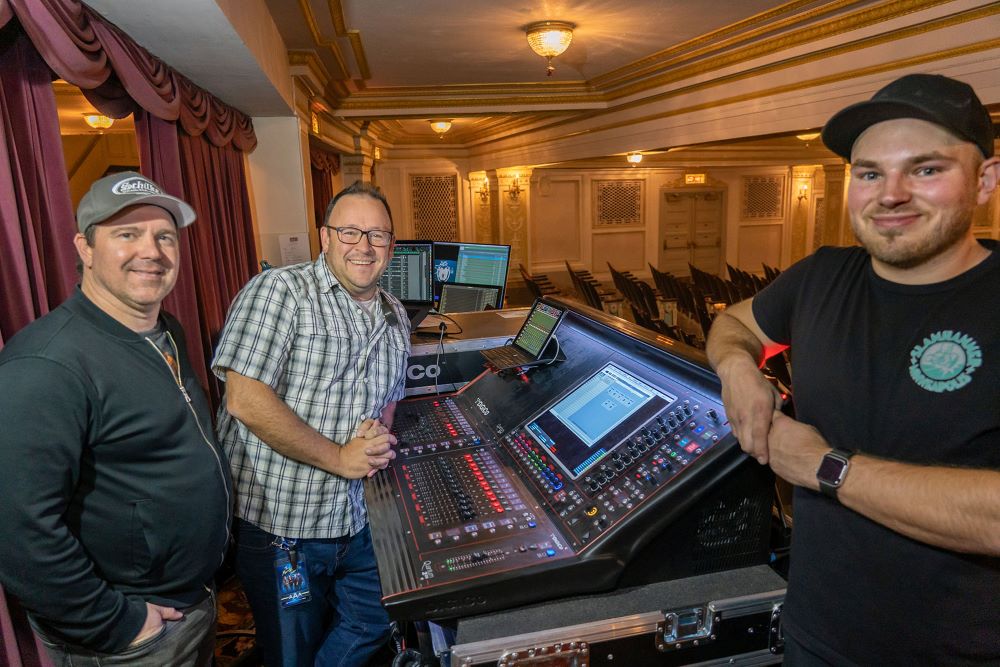The ongoing Manhattan Transfer’s 50th Anniversary & Final World Tour, featuring the Grammy award–winning vocal group founded in 1969 that’s explored a cappella, vocalese, swing, standards, Brazilian jazz, rhythm and blues, pop music, and more over five decades, is equipped with a pair of DiGiCo Quantum225 consoles for front of house and monitors supplied by Twin Cities-based live-production provider Slamhammer.
As the foursome prepared for the initial dates their 50th Anniversary outing last August and September, circumstances compelled them to hit the road with the barest minimum of tech rehearsal in light of a combination of pandemic exigencies and shortages. “It’s a pretty big show — a big band with 24 pieces: 12 horns, two drum kits, and three basses,” explains Andrew Lefkowits, the tour’s FOH engineer, who joined monitor engineer Chad Willis and Tyler Cerny, Slamhammer’s system tech for the tour, on the road.
“We didn’t have a lot of time to build a show before heading out and the layout flexibility of the Quantum console is just amazing,” he continues. “I could build my fader banks with exactly the right elements in each and place them where I could get at them quickly and confidently. On this show, I need all four vocal faders under my fingers at all times, because each individual singer will have moments where they jump out and then fall back into the harmonies.
“And I had to build three separate layers based on instrumentation: one for them with the Transfer Band, one for them with the Big Band, and one for when everyone was playing together. Having that layering capability was huge, especially since I literally started building the layers on the first soundcheck, three hours before doors.”
Quantum’s Mustard processing also played a part in getting everything up to speed. “I’m using Mustard’s compression on the individual kick drums and the basses, two uprights and an electric, and then also applying it to the overall drum buss,” he explains. “The great thing about Mustard is that even though I didn’t have a lot of time to get too deeply into it, it sounded great as soon as I turned it on. On this tour, with everything having to come together quickly, that made a huge difference.”
Over at monitors, Willis, who like Lefkowits has been with the quartet for the better part of a decade, notes that the Virtual Soundcheck capability became critical night after night, allowing him to import the multitrack recording of a previous performance on USB-over-MADI into the desk to virtually run down the show at each stop on the tour. TMT’s monitoring is as complex as the stage setup: the vocalists have four front wedges and two side-fill wedges in addition to the in-ear monitors three of the members also use. The sax, trumpet, and trombone sections each have their own wedges, as do the bass and drummer, who also has his own mixer on stage. “It’s a lot of mixes but the 225 makes it easy to handle,” says Willis.
One of the ways it does that is via the ability to have virtually the console worksurface available on an iPad, which allows Willis, who is on his own wireless IEM — he’s used to mixing vocal groups live over headphones to minimize bleed onstage — to roam the stage during soundcheck, making sure everyone’s monitors are dialed in. “I can solo a channel right next to someone and dial them in precisely,” he adds. “I’m literally carrying the console around with me.”
He’s also using the Spice Rack’s Chilli 6 multi-band and Naga 6 EQ features on the IEMs, which he uses to manage volume as a show progresses. “By mid-show and towards the end, we’re often at completely different volume levels, and they don’t like their ears to be too loud, so the compression helps me manage that for them,” he concludes. “I used to travel with a classic hardware compressor for that, and it’s nice now to be able to get that same easy-over compression effect without needing that piece of gear. And as they get louder, they’re hitting certain frequencies harder, and the dynamic EQ lets me keep the tone consistent for them. For both Andrew and me, having the Quantum225 on the road has made a world of difference. It’s a great way to celebrate a 50th anniversary.”




















